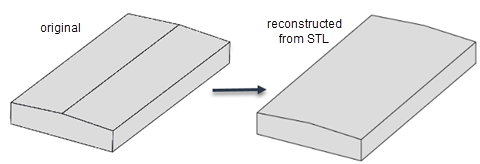importGeometry
STL 또는 STEP 파일에서 지오메트리 가져오기
구문
설명
gm = importGeometry(geometryfile)
gm = importGeometry(model,geometryfile)model 컨테이너에 포함시킵니다.
___ = importGeometry(___,는 하나 이상의 이름-값 인수를 사용하여 지오메트리 객체를 만듭니다. 이 구문을 위에 열거된 구문의 인수 조합과 함께 사용할 수 있습니다.Name=Value)
예제
입력 인수
이름-값 인수
출력 인수
제한 사항
importGeometry는 하위 도메인들이 공통 점을 갖는 멀티도메인 2차원 또는 3차원 지오메트리를 가져오는 것을 허용하지 않습니다. 지오메트리의 하위 도메인들이 공통 점을 갖는 경우에도 툴박스는 여전히 이 하위 도메인들이 서로 연결되지 않았고 하위 도메인 간에 공통 인터페이스가 없는 것으로 간주합니다. 각 하위 도메인은 자체 메시를 갖습니다.이러한 제한으로 인해 중첩된 3차원 지오메트리를 직접 가져올 수 없습니다. 우회적 해결 방법으로, 메시를 가져온 다음
geometryFromMesh함수를 사용하여 그 메시에서 멀티도메인 지오메트리를 만들 수 있습니다. Multidomain Geometry Reconstructed from Mesh 항목을 참조하십시오.
팁
STL 형식은 삼각형 모음을 사용하여 CAD 지오메트리의 경계를 근사하고,
importGeometry함수는 이 데이터로부터 면과 모서리를 재구성합니다. STL 데이터로부터의 재구성은 정밀하지 않고 모서리 손실이 발생할 수 있어, 인접한 면이 병합될 수 있습니다. 대개 손실되는 모서리는 작은 각도로 만나는 인접한 두 면 사이의 모서리이거나 블랜드 곡면(blend surfaces)의 경계가 되는 매끄러운 모서리입니다. 일반적으로 이러한 모서리 손실은 해석 워크플로에 영향을 미치지 않습니다.
STL 지오메트리는 원본 CAD 지오메트리의 근사에 불과하므로 STL 지오메트리와 CAD 지오메트리의 면적과 부피가 서로 다를 수 있습니다.




